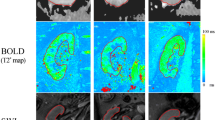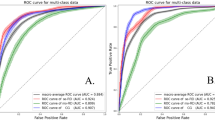Abstract
Objective
To explore whether a radiomics signature based on diffusion tensor imaging (DTI) can detect early kidney damage in diabetic patients.
Materials and methods
Twenty-eight healthy volunteers (group A) and thirty type 2 diabetic patients (group B) with micro-normoalbuminuria, a urinary albumin-to-creatinine ratio (ACR) < 30 mg/g and an estimated glomerular filtration rate (eGFR) of 60–120 mL/(min 1.73 m2) were recruited. Kidney DTI was performed using 1.5T magnetic resonance imaging (MRI).The radiologist manually drew regions of interest (ROI) on the fractional anisotropy (FA) map of the right kidney ROI including the cortex and medulla. The texture features of the ROIs were extracted using MaZda software. The Fisher coefficient, mutual information (MI), and probability of classification error and average correlation coefficient (POE + ACC) methods were used to select the texture features. The most valuable texture features were further selected by the least absolute shrinkage and selection operator (LASSO) algorithm.
A LASSO regression model based on the radiomics signature was established. The diagnostic performance of the model for detecting early diabetic kidney changes was evaluated by the area under the receiver operating characteristic (ROC) curve (AUC). Empower (R), R, and MedCalc15.8 software were used for statistical analysis
Results
A total of 279 texture features were extracted from ROI of the kidney, and 30 most valuable texture features were selected from groups A and B using MaZda software. After LASSO-logistic regression, a diagnostic model of diabetic kidney damage based on texture features was established.
Model discrimination evaluation: AUC = 0.882 (0.770 ± 0.952). Model calibration evaluation: Hosmer–Lemeshow X2 = 5.3611, P = 0.7184, P > 0.05, the model has good calibration.
Conclusion
The texture features based on DTI could play a promising role in detecting early diabetic kidney damage.



Similar content being viewed by others
References
Foundation N K. KDOQI Clinical Practice Guideline for Diabetes and CKD: 2012 Update[J]. Am J Kidney Dis,2012,60(5):850-886.
Ye X J, Cui S H, Song J W, et al. Using magnetic resonance diffusion tensor imaging to evaluate kidney function changes in diabetic patients with early-stage chronic kidney disease[J]. Clinical Radiology,2019,74(2):116-122.
Deng Y, Yang B, Peng Y, et al. Use of intravoxel incoherent motion diffusion-weighted imaging to detect early changes in diabetic kidneys[J]. Abdominal Radiology,2018,43(10):2728-2733.
Kaimori J, Isaka Y, Hatanaka M, et al. Visualization of kidney fibrosis in diabetic nephropathy by long diffusion tensor imaging MRI with spin-echo sequence[J]. SCIENTIFIC REPORTS,2017,7(5731).
Gaudiano C, Clementi V, Busato F, et al. Diffusion tensor imaging and tractography of the kidneys: assessment of chronic parenchymal diseases[J]. European Radiology,2013,23(6):1678-1685.
Liu Z, Xu Y, Zhang J, et al. Chronic kidney disease: pathological and functional assessment with diffusion tensor imaging at 3T MR[J]. European Radiology,2015,25(3):652-660.
Wang W, Pui M H, Guo Y, et al. 3T magnetic resonance diffusion tensor imaging in chronic kidney disease[J]. Abdominal Imaging,2014,39(4):770-775.
Ding J, Xing Z, Jiang Z, et al. Evaluation of kidney dysfunction using texture analysis based on DWI, BOLD, and susceptibility-weighted imaging[J]. European Radiology,2019,29(5):2293-2301.
Yao Y.J,Zhu.B.Y,Zheng Y.R, et al.Principle of DWI, BOLD, DTI and their progresses in diagnosis of diabetic kidne y disease [J]. Chin J Med Imaging Technol, 2016,32(05):803-806.
Feng Y Z, Chen X Q, Yu J, et al. Intravoxel incoherent motion (IVIM) at 3.0 T: evaluation of early kidney function changes in type 2 diabetic patients[J]. Abdom Radiol (NY),2018,43(10):2764-2773.
Feng YZ, Ye YJ, Cheng ZY, et al. Non-invasive assessment of early stage diabetic nephropathy by DTI and BOLD MRI. Br J Radiol. 2020. 93(1105): 20190562.
Otero HJ, Calle-Toro JS, Maya CL, Darge K, Serai SD. DTI of the kidney in children: comparison between normal kidneys and those with ureteropelvic junction (UPJ) obstruction. MAGMA. 2020. 33(1): 63-71.
Selby NM, Blankestijn PJ, Boor P, et al. Magnetic resonance imaging biomarkers for chronic kidney disease: a position paper from the European Cooperation in Science and Technology Action PARENCHIMA. Nephrol Dial Transplant. 2018. 33(suppl_2): ii4-ii14
Lambin P, Rios-Velazquez E, Leijenaar R, et al. Radiomics: Extracting more information from medical images using advanced feature analysis[J]. European Journal of Cancer,2012,48(4):441-446.
Gillies R J, Kinahan P E, Hricak H. Radiomics: Images Are More than Pictures, They Are Data[J]. Radiology,2016,278(2):563-577.
Lambin P, Rios-Velazquez E, Leijenaar R, et al. Radiomics: extracting more information from medical images using advanced feature analysis[J]. Eur J Cancer,2012,48(4):441-446.
Kline T L, Korfiatis P, Edwards M E, et al. Image texture features predict kidney function decline in patients with autosomal dominant polycystic kidney disease[J]. Kidney International,2017,92(5):1206-1216.
Ding J, Xing Z, Jiang Z, et al. CT-based radiomic model predicts high grade of clear cell kidney cell carcinoma[J]. Eur J Radiol,2018,103:51-56.
Shu J, Tang Y, Cui J, et al. Clear cell kidney cell carcinoma: CT-based radiomics features for the prediction of Fuhrman grade[J]. Eur J Radiol,2018,109:8-12.
Abbasian A A, Mohammadi A, Khalili N B, et al. Assessment of Kidney Function After Allograft Transplantation by Texture Analysis[J]. Iran J Kidney Dis,2017,11(2):157-164.
S H. Sensing the texture of imaging, a new biomarker of polycystic kidney disease. [J]. Kidney Int,2017,92(5):1044-1045.
Inker LA, Schmid CH, Tighiouart H, et al. Estimating glomerular filtration rate from serum creatinine and cystatin C. N Engl J Med. 2012. 367(1): 20-9.
Yang M, Yan Y, Wang H. IMAge/enGINE: a freely available software for rapid computation of high-dimensional quantification. Quant Imaging Med Surg. 2019. 9(2): 210-218
Tibshirani R. The lasso method for variable selection in the Cox model[J]. Stat Med,1997,16(4):385-395.
Cutajar M, Clayden J D, Clark C A, et al. Test–retest reliability and repeatability of kidney diffusion tensor MRI in healthy subjects[J]. European Journal of Radiology,2011,80(3):e263-e268.
Wang Y, Feng Y, Lu C, et al. Kidney fat fraction and diffusion tensor imaging in patients with early-stage diabetic nephropathy[J]. European Radiology,2018,28(8):3326-3334.
Razek A A K A, Al-Adlany M A A A, Alhadidy A M, et al. Diffusion tensor imaging of the kidney cortex in diabetic patients: correlation with urinary and serum biomarkers[J]. Abdominal Radiology,2017,42(5):1493-1500.
Wang Y, Yan X, Pu H, et al. In vivo evaluation of early kidney damage in type 2 diabetic patients on 3.0 T MR diffusion tensor imaging[J]. World Journal of Radiology,2018,10(8):83-90.
Raja R, Sinha N, Saini J, et al. Assessment of tissue heterogeneity using diffusion tensor and diffusion kurtosis imaging for grading gliomas[J]. Neuroradiology,2016,58(12):1217-1231.
Tian Y, Liu Z, Tang Z, et al. Radiomics Analysis of DTI Data to Assess Vision Outcome After Intravenous Methylprednisolone Therapy in Neuromyelitis Optic Neuritis[J]. J Magn Reson Imaging,2019,49(5):1365-1373.
Skogen K, Schulz A, Helseth E, et al. Texture analysis on diffusion tensor imaging: discriminating glioblastoma from single brain metastasis[J]. Acta Radiologica,2018,60(3):356-366.
Liu M X. Research on Classification and Retrieval of Texture Images [D]. Shandong normal University, 2006.
Yang X M. Image feature extraction and classification based on multi-scale geometric analysis [D]. Xidian University, 2010.
Funding
This work was supported by the Guangzhou Key Laboratory of Molecular and Functional Imaging for Clinical Translation (201905010003) and Engineering Research Center of Medical Imaging Artificial Intelligence for Precision Diagnosis and Treatment, Guangdong Province.
Author information
Authors and Affiliations
Corresponding author
Ethics declarations
Conflict of interest
All authors declare that they have no conflicts of interest.
Informed consent
Informed consent was obtained from all participants included in the study.
Additional information
Publisher's Note
Springer Nature remains neutral with regard to jurisdictional claims in published maps and institutional affiliations.
Rights and permissions
About this article
Cite this article
Deng, Y., Yang, Br., Luo, Jw. et al. DTI-based radiomics signature for the detection of early diabetic kidney damage. Abdom Radiol 45, 2526–2531 (2020). https://doi.org/10.1007/s00261-020-02576-6
Published:
Issue Date:
DOI: https://doi.org/10.1007/s00261-020-02576-6




